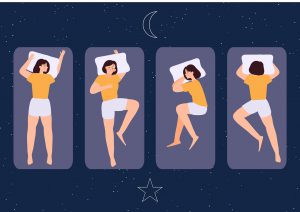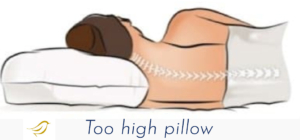Your sleeping position can impact your health—here’s what an expert recommends
When it comes to getting a good night’s sleep, there are so many factors to consider: blue light, stress, diet – the list goes on. But one often overlooked factor that could be making or breaking your nightly snooze is your sleep position.

Are you a side sleeper? A stomach sprawler? Odds are you probably have a preferred position. But according to naturopathic sleep doctor, Catherine Darley N.D., how we sleep is something worth paying more attention to.
How your sleeping position affects spinal alignment
As anyone with back issues likely knows, it can feel like an accomplishment to wake up without a sore back. That’s because, between less than optimal pillows and old mattresses, our spines are thrown all out of whack at night.
As such, “if you have spinal alignment issues or pain,” Darley says, “you want to sleep in a position that has your spine as aligned as possible.” The spin has a natural “S” curvature, doming slightly in the upper back and curving inward in the lower back. It’s important to support these curves, either with proper pillow placement, or readjusting your position entirely.
“Sleeping on your back can be good and healthy, but your pillow should be really flat to that so you don’t have your chin to your chest,” Darley notes. Additionally, being too elevated on your pillow can put pressure on the low back. “Maybe they have really big pillow so their neck is cranked up to the side, or it’s maybe they have too flat of a pillow and their neck is sagging down casing misalignment,” she says, “and over years that’s not good for your cervical spine.”
For extra support on your back without investing in a brand new mattress, you can pursue putting a small pillow under your low back, and one under the bend of your knees.
How it affects the breath
From snoring to sleep apnea, the breath is another sleep factor that makes a big difference. Have you heard of those folks who tape their mouths shut to breathe better at night?
“If a person snores or has sleep apnea,” Darley says, “then sleeping on their back is going to make that worse, because the airway will have gravity working against it.” In this case, she says lying on your side is probably your best bet. “When you’re lying on your side,” she adds, “make sure you maybe have a pillow between your knees to keep your lower back in alignment. And thinking about the cervical spine, you want to have a pillow that’s the right height.” According to her, your pillow’s should be about the distance from the edge of your shoulder to your ear when you’re in neutral alignment.
The bottom line
The bottom line is, for the sake of your spine and your breath, it’s important to figure out what a healthy sleeping position looks like for you. If it’s on your back, make sure the spines natural curves are supported. And if you have breathing issues, your side will do – but again, check in with spinal alignment.
“People do have sleep associations that are formed often in young childhood, where we’re not going to fall asleep until we’re in our favorite sleep-onset position,” Darley notes, but adds that with intention and a little patience, you can train yourself to get used to a better position.
So, if you’ve been waking up every morning feeling stiff and/or groggy, your sleep position may just be the factor to transform. It will help your spine, ensure you’re breathing properly, and above all else, help you to feel rested and restored upon waking.



yogaesoteric
November 28, 2022
Also available in:
 Français
Français
